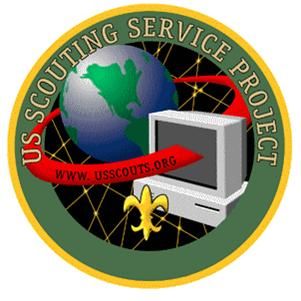General Information
The Guide to Advancement (Publication No. 33088) and information posted on Scouting.org, are the official Boy Scouts of America sources on Scouts BSA advancement procedures. The current edition is the Guide to Advancement 2021.
When there is a conflict between two published lists of requirements, such as those posted on Scouting.org or in the current edition of Scouts BSA Requirements and those which appear in a Merit Badge pamphlet or in the Scouts BSA handbooks, the requirements posted on Scouting.org or in the current edition of Scouts BSA Requirements should normally be considered to be the controlling document.
No council, district, unit, or individual has the authority to add to, or to subtract from, any advancement or merit badge requirements. For more detailed information, see the Guide to Advancement, which is available online at www.scouting.org/resources/guide-to-advancement
The following excerpt from the 2021 edition of the Guide to Advancement explains what to do when merit badge requirements change:
7.0.4.3 What to Do When Requirements Change
Merit badge requirements, along with changes to them, can be found at the Scouting.org Merit Badges web page: www.scouting.org/programs/scouts-bsa/advancementand- awards/merit-badges. Once new or revised requirements appears on that page, any Scout beginning work on a merit badge must use the requirement as stated there.
Changes may also be introduced in a revised merit badge pamphlet, youth handbook, or other official BSA publication or release before appearing on the Merit Badges web page. In this case, unless official communications set forth a different procedure or establish a date by when use of the old requirements must cease, youth members have through December 31 of that year to decide what to do. They may continue - or begin work - using the old requirements, or they may switch to - or begin work - using the new requirements. Scouts who choose to use the old requirements may continue using them until the merit badge is completed. Scouts who have not begun work on a badge by December 31 of the year a change in its requirements is announced must use the new requirements.
There is no time limit between starting and completing a badge, although a counselor may determine so much time has passed since any effort took place that the new requirements must be used.
Index of Changes
RANK ADVANCEMENT CHANGESScout
|
MERIT BADGE CHANGES |
MERIT BADGE CHANGES MISSINGLifesavingThe requirements for this merit badge were revised in 2021, but were NOT changed in the 2022 and 2023 Scouts BSA Requirements books. |
SPECIAL OPPORTUNITIES CHANGESCyber Chip
|
Changes to Rank Requirements
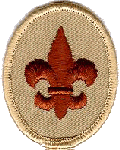 Scout
Scout
Revisions were made, effective on August 1 2022, to requirements 1e, 5, and 6 as shown below.
- Repeat from memory the Outdoor Code. In your own words, explain what the Outdoor Code means to you. List the seven principles of Leave No Trace. Explain the difference between the two.
- Tell what you need to know about pocketknife safety and responsibly.
- With your parent or guardian, complete the exercises in the pamphlet "How to Protect Your Children from Child Abuse: A Parents Guide" and earn the Cyber Chip Award for your grade or view the Personal Safety Awareness videos (with your parent or Guardian's permission). 1
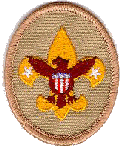 Tenderfoot
Tenderfoot
Revisions were made, effective on August 1 2022, to requirements 1c, 5a, and 5c as shown below. An additional requirement (5d) was also added, without notice. It did not appear in the list of changes, nor in the draft 2023 Scouts BSA Requirements book, but was added to the requirements that are listed in the newest Scouts BSA Handbooks.
- Tell how you practiced Explain how you demonstrated the Outdoor Code and Leave No Trace on a campout or outing.
- Explain the importance of the buddy system as it relates to your personal safety on outings and in your neighborhood where you live. Use the buddy system while on a troop or patrol outing.
- Explain the rules of safe and responsible hiking, both on the highway and cross-country, during the day and at night.
- Explain why it is important to hike on trails or other durable surfaces, and give examples of durable surfaces you saw on your outing.
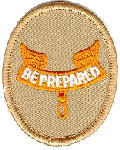 Second Class
Second Class
Revisions were made, effective on August 1 2022, to requirements 1b, 2b, and 2c as shown below.
- Explain Recite the principles of Leave No Trace, and tell how you practiced them on a campout or outing. This outing must be different from the one used for Tenderfoot requirement 1c. from memory. Explain how you follow them on all outings.
- Use the tools listed in Tenderfoot requirement 3d a pocketknife, and a saw or axe if needed, to prepare tinder, kindling, and fuel wood for a cooking fire.
- At Using a minimum-impact method, and at an approved outdoor location and time, use the tinder, kindling, and fuel wood from Second Class requirement 2b to demonstrate how to build a fire. Unless prohibited by local fire restrictions, light the fire. After allowing the flames to burn safely for at least two minutes, safely extinguish the flames with minimal impact to the fire site. Properly dispose of the ashes and any charred remains.
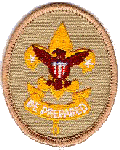 First Class
First Class
Revisions were made, effective on August 1 2022, to requirements 1b and 2d as shown below.
- Explain each of the principles of Tread Lightly! and tell how you practiced them on a campout or outing. This outing must be different from the ones used for Tenderfoot requirement 1c and Second Class requirement 1b. the potential impacts of camping, both on the environment and on other outdoor users. Explain why the Outdoor Code and Leave No Trace principles are important for protecting the outdoors.
- Demonstrate the procedures to follow in the safe handling and storage of fresh meats, dairy products, eggs, vegetables, and other perishable food products. Show how to properly dispose of camp garbage, cans, plastic containers, waste water and other rubbish.
 Star
Star
Revisions were recently made to requirements 3 and 6. The revision to requirement 3, took effect on November 1, 2021, while the revision to requirement 6 became effective on August 1 2022.
Note that Scouts could use Citizenship in Society as one of the Eagle-Required merit badges for Star rank requirement #3 any time after that date, which was when the Citizenship in Society merit badge was released. Since when it was released it was immediately listed as a required badge in Eagle rank requirement 3, even though the merit badge did not actually become required for the rank of Eagle Scout until July 1, 2022. There are now a total of 18 merit badges in the list of required badges in Eagle requirement 3.
- Earn six merit badges, including any four from the required list for Eagle. You may choose any of the 17 merit badges on the required list for Eagle to fulfill this requirement. See Eagle rank requirement 3 for this list.
- With your parent or guardian, complete the exercises in the pamphlet "How to Protect Your Children from Child Abuse: A Parents Guide" and earn the Cyber Chip Award for your grade or view the Personal Safety Awareness videos (with your parent or Guardian's permission). 7
 Life
Life
Similar to the change to the Star rank requirements, mentioned above, a revision was also made to Life rank requirement 3, which took effect on November 1, 2021.
- Earn five more merit badges (so that you have 11 in all) including any number more from the list for Eagle so that you have a total of seven from the required list of Eagle in that total number of 11 merit badges. You may choose any of the 17 merit badges on the required list for Eagle to fulfill this requirement. See Eagle rank requirement #3 for this list.
 Eagle
Scout
Eagle
Scout
When the Citizenship in Society merit badge was introduced on November 1, 2021, BSA announced that the new merit badge would become the 14th merit badge required for Scouts to advance to Eagle Scout effective on July 1, 2022. Interim changes were made to the list in Eagle requirement 3 on November 1, 2021, and finalized on July 1, 2022. The result of the changes to requirement 3 is shown below.
- Earn a total of 21 merit badges (10 more than required for the Life rank), including these 13 14 merit badges:
- First Aid
- Citizenship in the Community
- Citizenship in the Nation
- Citizenship in Society
- d. Citizenship in the World
- e. Communication
- f. Cooking
- g. Personal Fitness
- h. Emergency Preparedness OR Lifesaving
- i. Environmental Science OR Sustainability
- j. Personal Management
- k Swimming OR Hiking OR Cycling
- l. Camping, and
- m. Family Life, and
n. *Citizenship in SocietyYou must choose only one of the merit badges listed in categories h, i, and k i, j, and l. Any additional merit badge(s) earned in those categories may be counted as one of your eight seven optional merit badges used to make your total of 21.
REVISED Merit Badges
 American
Business
American
Business
A change was made to requirement 2c, as shown below
- Explain how a sole proprietorship, or partnership, or limited liability company gets its capital. Discuss and explain four ways a corporation obtains capital.
 Animal
Science
Animal
Science
Changes were was made to requirement 1, and 6-Avian Option a, c, and e, as shown below
- Name four breeds of livestock in each of the following classifications: horses, dairy cattle, beef cattle, sheep, hogs, poultry, and goats. Tell their principal uses and merits. Tell where the breeds originated.
- Avian Option
- Make a sketch of a layer house or broiler house showing nests, roosts, feeders, waterers, and means of ventilation. Explain how insulation, ventilation, temperature controls, automatic lights, and other environmental controls are used to protect birds from heat, cold, and bad weather. Explain the importance of light for egg production.
- Tell about the grading of eggs. Tell how broilers (fryers) are graded. Describe the classes of chicken meat.
- Define the following terms: hen, rooster, chick, capon, tom, poult. chick, pullet, hen, cockerel, cock, capon.
 Archery
Archery
The following requirements were revised as shown below:
- Item 1a was replaced, including items 1a1, 1a2, and 1a3, item 1b was replaced, a new item 1c was added, and old item 1c was renumbered as 1d
- Item 3b was revised, and item 3c was deleted (but was not included in the list of changes).
- Item 4a was deleted, and 4b-4e were renumbered as 4a-4d.
- In requirement 5, Options A and B each had the following changes: Item c was revised, item f1c was deleted, item f1d was revised and renumbered as f1c, item f1e was renumbered as f1d, and item f2 was revised.
- Do the following:
- State and explain the Range Safety Rules.
Explain the five range safety rules.
- Three safety rules when on the shooting line.
- Three safety rules when retrieving arrows.
- The four whistle commands used on a range and their related verbal commands.
- State and explain the general safety rules for archery. Demonstrate how to safely carry arrows in your hands.
Explain the four whistle commands used on the range.- Explain how to safely remove arrows from the target and return them to your quiver.
- c. Tell about your local and state laws for owning and using archery equipment.
- Explain the following terms: cast, draw length, draw weight, string height, aiming, spine, mechanical release, and barebow.
- Make a bowstring using appropriate materials.
- Explain the following:
- The importance of obedience to a range officer or other person in charge of a range.
b.The difference between an end and a round.- c.The differences among field, target, and 3-D archery.
- d.How the five-color World Archery Federation (FITA) target is scored.
- e.How the National Field Archery Association (NFAA) black-and-white field targets and blue indoor targets are scored.
- Option A
- Show the 10 steps of good shooting Demonstrate and explain USA Archery's "Steps of Shooting" for the bow you are shooting.
- A Junior 900 round and make a score of 180 points.
d. A World Archery/ USA Archery indoor* round I and make a score of 80 points.- e. An NFAA indoor* round and make a score of 50 points.
- Shooting 30 arrows in five-arrow ends at an 80-centimeter (32-inch) five-color target at 10 yards and using the 10 scoring regions, make a score of 150 points.
- Option B
- Show the 10 steps of good shooting Demonstrate and explain USA Archery's "Steps of Shooting" for the bow you are shooting.
- A Junior 900 round and make a score of 180 points.
d. A World Archery/ USA Archery indoor* round I and make a score of 80 points.- e. An NFAA indoor* round and make a score of 50 points.
- Shooting at an 80-centimeter (32-inch) five-color target at 15 yards and using the 10 scoring regions, make a minimum score of 160 points . Accomplish this in the following manner:
Shoot 15 arrows in five-arrow ends, at a distance of 10 yards
AND
Shoot 15 arrows in five-arrow ends, at a distance of 15 yards.
 Architecture
Architecture
A change was made to requirement 1b, as shown below
- Select an a historical architectural achievement that has had a major impact on society. Using resources such as the Internet (with your parent's permission), books, and magazines, find out how this achievement has influenced the world today. Tell your counselor what you learned.
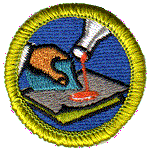 Composite
Materials
Composite
Materials
Changes were made to requirements 1c, 3a, and 3b, as shown below.
- Describe what a material safety data sheet (MSDS) (SDS) is and tell why it is used.
- Discuss three different composite reinforcement materials, their positive and negative characteristics, and their uses. Obtain the MSDS SDS for each one and discuss the toxicity, disposal, and safe-handling sections for these materials.
- Discuss three different resins used in composites, their positive and negative characteristics, and their uses. Obtain the MSDS SDS for each one and discuss the toxicity, disposal, and safe-handling sections for these materials. Include thermoset resins and thermoplastic resins in your discussion.
 Cooking
Cooking
Changes were made to requirements 2c, 2d, 4a, 5b, 5d, 5e, 5g, 6a, and 6f, as shown below.
- Determine Track your daily level of activity and your daily caloric need based on your activity level for five days. Then, based on the MyPlate food guide, discuss with your counselor an appropriate meal plan for yourself for one day.
- Discuss your current eating habits with your counselor and what you can do to eat healthier, based on the MyPlate food guide food allergies, food intolerance, and food-related illnesses and diseases. Explain why everyone who handles or prepares food needs to be aware of these concerns.
- Find recipes for each meal. Create a shopping list for your meals showing the amount of food needed to prepare and serve each meal, and for the number of people you will serve. Determine the cost for each meal.
- Create a shopping list for your meals showing the amount of food needed to prepare and serve each meal, and the cost for each meal. Find or create recipes for at least three meals, a dessert and a snack. Adjust menu items in the recipes for the number to be served. Create a shopping list and budget to determine the per-person cost.
- In the outdoors, using your menu plans and recipes for this requirement, cook two three of the five meals you planned using either a lightweight stove or a low-impact fire. Use a different cooking method from requirement 3 for each meal. You must also cook a third meal using either a Dutch oven OR a foil pack OR kabobs. camp stove OR backpack stove. Use a skillet over campfire coals OR a Dutch oven for a fourth meal, and cook the fifth meal in a foil pack OR on a skewer. Serve all of these meals to your patrol or a group of youth. **
- In the outdoors, prepare a dessert OR a snack and serve it to your patrol or a group of youth.**
- Explain to your counselor how you cleaned Lead the clean-up of the equipment, utensils, and the cooking site thoroughly after each meal. Explain how you properly disposed of Properly store or dispose unused ingredients, leftover food, dishwater and of all garbage.
- Using the MyPlate food guide or the current USDA nutrition model, plan a menu meal for trail hiking or backpacking that includes one breakfast, one lunch, one dinner, and one snack. These meals must not require refrigeration and are to be consumed by three to five people (including you). Be sure to keep in mind any special needs (such as food allergies) and how you will keep your foods safe and free from cross-contamination. List the equipment and utensils needed to prepare and serve these meals.
- Discuss how you followed the Outdoor Code and no-trace principles during your outing. Explain to your counselor how you cleaned any equipment, utensils, and the cooking site after each meal. Explain how you properly disposed of any dishwater and packed out all garbage.
Explain to your counselor how you should divide the food and cooking supplies among the patrol in order to share the load. Discuss how to properly clean the cooking area and store your food to protect it from animals.
 Cycling
Cycling
The requirements were significantly revised and rearranged, as follows:
- Item 1 - no change; Item 1a - revised; Item 1b - no change; Item 1c - although no change was indicated, this requirement should have been deleted, as it duplicates requirement 3.
- Item 2 - replaced
- Items 3, 3a, and 3c - replaced with a new item 3 (formerly item 1c) ; Item 3b moved to 4a
- Item 4 - replaced; Item 4a - moved from 3b; Items 4b, 4c, 4d, and 4f - added; Item 4e - moved from item 5
- Item 5 - moved to item 4e and replaced
- Item 6 - Deleted
- Item 7 - renumbered as item 6
- Changes to Item 6-Option A:
- Items a, a1, and a3 - replaced; Item a2 - no change
- Item b - revised
- Item c - no change; Items c1 and c2 - revised
- Changes to Item 6-Option B:
- Item a - replaced and moved to item b; Item a1 - replaced;
Item a2 - no change; Item a3 - replaced and moved to Item b1;
Item a4 - deleted; Items a5 and a6 - moved to items b2 and b3 - Item b - moved from item a; Item b1 - moved from Item a3; Items b2 and b3 - moved from Items a5 and a6
- Items b, c, and d - renumbered as items c, d, and e
- Item a - replaced and moved to item b; Item a1 - replaced;
Item a2 - no change; Item a3 - replaced and moved to Item b1;
- Changes to Item 6-Option A:
The items with changes are shown below.
- Explain to your counselor the most likely hazards you may encounter while participating in cycling activities and what you should do to anticipate, help prevent, mitigate, and respond to these hazards. Explain to your counselor how to ride predictability, be conspicuous, think ahead, and ride ready.
- Clean and adjust a bicycle. Prepare it for inspection using a bicycle safety checklist. Be sure the bicycle meets local laws.
Describe your state and local laws concerning bicycles. Discuss what is the same and what is different from laws applying to motor vehicles. Explain where and how you should ride on roads and streets to include lane position, changing lanes, making left and right turns, and riding through intersections.- Show your bicycle to your counselor for inspection. Point out the adjustments or repairs you have made. Do the following:
- Show all points that need oiling regularly.
- Show points that should be checked regularly to make sure the bicycle is safe to ride.
- Explain the importance of wearing a properly sized and fitted helmet while cycling and of wearing the right clothing for the weather. Know the BSA Bike Safety Guidelines.
- Describe how to brake safely with foot brakes and with hand brakes.
Using a bicycle safety checklist, clean and adjust a bicycle and present it to your counselor for inspection. Do the following:
- Show points that should be checked regularly to make sure the bicycle is safe to ride.
- Show how to adjust the saddle and handlebars for a proper fit.
- Show how to adjust brakes and gear shifting (derailleurs).
- Show all points that need regular lubrication.
- Show how to repair a flat by removing the tire, replacing or patching the tube, and remounting the tire.
- Show that the bicycle meets local laws.
- Show how to repair a flat by removing the tire, replacing or patching the tube, and remounting the tire.
Demonstrate basic bicycle handling skills to your counselor, to include how to properly mount your bicycle, starting and stopping (to include emergency stops), riding in a straight line, turning, shifting gears, scanning, and signaling.- Describe your state and local traffic laws for bicycles. Compare them with motor-vehicle laws. Know the bicycle-safety guidelines.
7. Using the BSA buddy system, complete all of the requirements for ONE of the following options: road biking OR mountain biking.*
- OPTION A - Road Biking
- Take a road test with your counselor and demonstrate the following:
- Properly mount, pedal, and brake, including emergency stops.
2. On an urban street with light traffic, properly execute a left turn from the center of the street; also demonstrate an alternate left-turn technique used during periods of heavy traffic.- 3. Properly execute a right turn.
- 4. Demonstrate appropriate actions at a right-turn-only lane when you are continuing straight.
- 5. Show proper curbside and road-edge riding. Show how to ride safely along a row of parked cars.
- 6. Cross railroad tracks properly.
- Avoiding main highways, take two rides of 10 miles each, two rides of 15 miles each, and two rides of 25 miles each. You must make a report of the rides taken. List dates for the routes traveled, and interesting things seen on the ride.
- Lay out on a road map a 50-mile trip. Stay away from main highways. Using your map, make this ride in eight hours or less.
- Participate in an organized bike tour of at least 50 miles. Make this ride in eight hours or less. Afterward, use the tour's cue sheet to make a map of the ride.
- OPTION B - Mountain Biking
- Take a trail ride with your counselor and demonstrate the following:
Demonstrate the following mountain bike handling skills to your counselor:
- Properly mount, pedal, and brake, including emergency stops.
Neutral position, ready position, bike body separation (side to side, and forward and back), and body positioning for cornering.- Show proper trail etiquette to hikers and other cyclists, including when to yield the right-of-way.
Show proper technique for riding up (seated, crouched, and standing)and down hill.- Take a trail ride with your counselor and demonstrate the following:
- Show proper trail etiquette to hikers and other cyclists, including when to yield the right-of-way.
- 4. Show proper technique for riding up and down hills.
5. Demonstrate how to correctly cross an obstacle by either going over the obstacle on your bike or dismounting your bike and crossing over or around the obstacle.- 6. Cross rocks, gravel, and roots properly.
- b. Describe the rules of trail riding, including how to know when a trail is unsuitable for riding.
- c. On trails approved by your counselor, take two rides of 2 miles each, two rides of 5 miles each, and two rides of 8 miles each. You must make a report of the rides taken. List dates for the routes traveled, and interesting things seen.
- d. After fulfilling the previous requirement, lay out on a trail map a 22-mile trip. You may include multiple trail systems, if needed. Stay away from main highways. Using your map, make this ride in six hours.
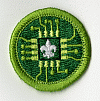 Digital
Technology
Digital
Technology
Changes were made to requirements 3a, 3e, 4a, 5a, and 7c, as shown below.
- Explain to your counselor how text, sound, and pictures, and videos are digitized for storage.
- Explain what a computer network is and describe the network's purpose the difference between a local area network (LAN) versus a wide area network (WAN)..
- Explain what a program or software application or "app" is and how it is created a computer uses a CPU and memory to execute it..
- Describe how digital devices are connected to at least two different ways data can be transferred through the internet.
- Discuss with your counselor an article or a news report (with your parent of guardian’s permission) a report on the internet about a recent legal case involving an intellectual property dispute.
 Disabilities
Awareness
Disabilities
Awareness
A change was made to requirement 6 as shown below.
- Make a commitment to your merit badge counselor describing what you will do to show a positive attitude about and toward people with disabilities and to encourage positive attitudes among others. Discuss how your awareness has changed as a result of what you have learned.
 Emergency
Preparedness
Emergency
Preparedness
A Change was made to requirement 3, as shown below. (No changes were made to the situations listed in items 3a-3d.)
- Show how you could safely save a person from the following dangerous situations without putting yourself in danger:
 Environmental
Science
Environmental
Science
Changes were made to requirements 3, 3f2, and 5 as shown below.
- Do ONE activity from seven SEVEN of the following EIGHT categories (using the activities in this {the merit badge} pamphlet as the basis for planning and carrying out your projects):
- Determine 10 ways to conserve resources or use resources more efficiently in your home, at school, or at camp. Practice at least two of these methods for seven five days and discuss with your counselor what you have learned.
- Using the construction project provided or a plan you create on your own, identify Identify the items that would need to be included in an environmental impact statement for the project planned a construction project such as building a house, adding a new building to your Scout camp, or one you create on your own that is approved by your counselor..
 Family
Life
Family
Life
Changes were made to requirement 6b. The introduction and Item 6b1 were replaced, a new requirement was added as item 6b2, old item 6b2 was renumbered as 6b3, and old item 6b3 was deleted as shown below.
- After this discussion, plan and carry out a family meeting* to include the following subjects: Identify the items that would need to be included in an environmental impact statement for a construction project such as building a house, adding a new building to your Scout camp, or one you create on your own that is approved by your counselor.
Prepare a meeting agenda that includes the following topics, review it with your parents or guardians, and then carry out one or more family meetings:
- Avoiding substance abuse, including tobacco, alcohol, and drugs, all of which negatively affect your health and well-being
How living the principles of the Scout Oath and Scout Law contributes to your family life- The greatest dangers and addictions facing youth in today's society (examples include use of tobacco products, alcohol, or drugs and other items such as debts, social media, etc.)
- 2. Understanding the growing-up process and how the body changes, and making responsible decisions dealing with sex
How your chores in requirement 3 contributed to your role in the family
 Farm
Mechanics
Farm
Mechanics
Changes were made to requirement 1d, as shown below.
- Describe what a material safety data sheet (MSDS) (SDS) is and tell why it is used. Obtain the MSDS SDS for any engine coolant, oil, grease, fuel, hydraulic or transmission fluid, or other flammable or hazardous materials you use in meeting the requirements for this merit badge.
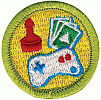 Game
Design
Game
Design
Changes were made to requirements 1b and 5d, requirement 8b was deleted, and requirement 8a was revised and split into 8a and 8b, as shown below.
- Describe four types of play value and provide an example of a game built around each concept. Discuss other reasons people play games.
Describe five different reasons that people play games. For each, give an example of a game that fits that reason.
- Describe the play value reason that someone would want to play your game..
- With your parent's or guardian's permission and your counselor's approval, visit with a professional in the game development industry and ask him or her about his or her them about their job and how it fits into the overall development process. Alternately, meet with a professional in game development education and discuss the skills he or she emphasizes in the classroom.
- List three career opportunities in game development. Pick one and find out about the education, training, and experience required for the profession. Discuss this with your counselor. Explain why this profession might interest you.
Alternatively, meet with a professional in game development education and discuss the skills they emphasize in the classroom.
 Genealogy
Genealogy
Requirement 1 was expanded by adding an introductio, renumbering the previous requirement 1 as 1a, and addng requirements 1b and 1c. Item 4 was revised with changes to 4a, a new item 4b, old 4b and 4c renumbered as 4c and 4d, and a new item 4e. Item 8c was added. The changesares shown below.
- 1. Explain to your counselor what the words genealogy, ancestor, and descendant mean.
- Explain what a family tree is and what information would be kept there.
- Explain what a family group record is and what information would be kept there.
- >Do EACH of the following:
- Name three types of physical genealogical resources Name three types of digital genealogical resources and where you can find them, and explain how these resources can help you chart your family tree. and explain how these resources can help you chart your family tree.
- Name three types of digital genealogical resources and where you can find them, and explain how these resources can help you chart your family tree.
- b. Obtain at least one genealogical document that supports an event that is or can be recorded on your pedigree chart or family group record. The document could be found at home or at a government office, religious organization, archive, or library.
- c. Tell how you found it and how you would evaluate the genealogical information you found for requirement 4b 4c.
- Tell a likely place to find these type of genealogical records: marriage record, census record, birth record, and burial information.
- Explain how record indexing works and how that has influenced genealogy.
 Geology
Geology
A change was made to requirement 5d2, as shown below.
- Explain the theory of plate tectonics. Make a chart explaining, or discuss with your counselor, how the processes of plate tectonics work. Discuss how plate tectonics determines the distribution of most of the Earth's volcanoes, earthquakes, and mountain belts.
 Golf
Golf
Changes were made to requirements 3 and 7g shown below.
- Tell about your understanding of the USGA system of handicapping World Handicap System.
- The sand iron shot, A recovery shot from a bunker or heavy rough recovery shots.
 Hiking
Hiking
The number and distances of the required hikes was changed from 1-5 miles, 3-10 miles, 1-15 miles, and 1-20 miles to 4-10 miles and 1-20 miles. .A new introduction was added to requirement 2, old item 2 was revised and renumbered as 2a, and new items 2b and 2c were added. Requirements 4 and 5 were revised and combined, and requirement 6 was revised and renumbered as 5, as shown below.
- Do the following:
- Explain and. where possible, show the points of good hiking practices including proper outdoor ethics, hiking safety in the daytime and at night, courtesy to others, choice of footwear, and proper care of feet and footwear.
- Read aloud or recite the Leave No Trace guidelines, and discuss why each is important while hiking.
- Read aloud or recite the Outdoor Code, and give examples of how to follow it on a hike
- Take the five following hikes four 10-mile hikes and one 20-mile hike, each on a different day, and each of continuous miles. These hikes MUST be taken in the following order
You may stop for as many short rest periods as needed, as well as one meal, during each hike, but not for an extended period (example: overnight). Prepare a written hike plan before each hike and share it with your Scoutmaster merit badge counselor or a designee. Include map routes, a clothing and equipment list, and a list of items for a trail lunch. * You may stop for as many short rest periods as needed, as well as one meal, but not for an extended period such as overnight. *
- One 5-mile hike
- Three 10-mile hikes
- One 15-mile hike
5. Take a hike of 20 continuous miles in one day following a hike plan you have prepared. You may stop for as many short rest periods as needed, as well as one meal, but not for an extended period (example: overnight). *- 6. After each of the hikes (or during each hike if on one continuous "trek") in requirements 4 and 5 requirement 4, write a short reflection of your experience. Give dates and descriptions of routes report on your hike. For each hike, give the date and description (or map) of the route covered, the weather, and any interesting things you saw, and any challenges you had and how you overcame them. It may include something you learned about yourself, about the outdoors, or about others you were hiking with. Share this with your merit badge counselor. *
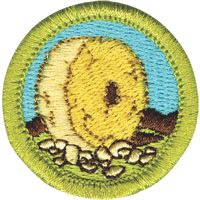 Inventing
Inventing
A change was made to requirement 6b as shown below.
- Create a model of the item using clay, cardboard, or any other readily available material. List the materials necessary to build a working prototype of the item.
 Lifesaving
Lifesaving
These changes were made in 2021, but were not included in the 2022 and 2023 Scouts BSA Requirements books. The official source is https://www.scouting.org/merit-badges/lifesaving/
Changes were made to requirements 1, 2. 15, and 16. The order of requirements 1 & 2 was reversed, and both are now prerequisites for requirements 3-15. The requirements to complete the swimming requirements for Second Class and First Class Ranks was replaced with a requirement to earn the Swimming Merit Badge. The order of requirements 15 and 16 was also reversed. Requirements 16 and 17 no longer must be completed after requirements 1 & 2. The changes are as follows:
- Before doing requirements 2 3 through 17 15, review with your counselor the principles of Safe Swim Defense.
- Complete Second Class rank requirements 5a through 5d and First Class rank requirements 6a, 6b, and 6e.**
- Second Class rank requirements 5a through 5d:
- (5a) Tell what precautions must be taken for a safe swim
- (5b) Demonstrate your ability to pass the BSA beginner test: Jump feetfirst into water over your head in depth, level off and swim 25 feet on the surface, stop, turn sharply, resume swimming, then return to your starting place.
- (5c) Demonstrate water rescue methods by reaching with your arm or leg, by reaching with a suitable object, and by throwing lines and objects.
- (5d) Explain why swimming rescues should not be attempted when a reaching or throwing rescue is possible. Explain why and how a rescue swimmer should avoid contact with the victim.
- First Class rank requirements 6a, 6b, and 6e:
- (6a) Successfully complete the BSA swimmer test.
- (6b) Tell what precautions must be taken for a safe trip afloat.
- (6e) With a helper and a practice victim, show a line rescue both as tender and as rescuer. (The practice victim should be approximately 30 feet from shore in deep water.)
- Swim continuously for 400 yards using each of the following strokes in a strong manner, in good form with rhythmic breathing, for at least 50 continuous yards: front crawl, sidestroke, breaststroke, and elementary backstroke.
- Discuss and review with your counselor the principles of BSA Safe Swim Defense.
Before doing requirements 3 through 15:
- Earn the Swimming merit badge.
- Swim continuously for 400 yards using each of the following strokes in a strong manner, in good form with rhythmic breathing, for at least 50 continuous yards: front crawl, sidestroke, breaststroke, and elementary backstroke.
- Demonstrate knowledge of resuscitation procedures:
16. Demonstrate management of a spinal injury to your counselor:
- Describe how to recognize the need for rescue breathing and CPR.
- Demonstrate CPR knowledge and skills, including rescue breathing, consistent with current guidelines.*
- Discuss the causes, signs, and symptoms of a spinal injury.
- Support a faceup subject in calm water of standing depth.
- Turn a subject from a facedown to a faceup position in water of standing depth while maintaining support.
- Demonstrate knowledge of resuscitation procedure:
- Describe how to recognize the need for rescue breathing and CPR.
- Demonstrate CPR knowledge and skills, including rescue breathing, on a mannequin under the guidance of a current CPR/AED instructor trained by a nationally certified provider.
 Mammal
Study
Mammal
Study
Changes were made to requirements 3a, 3b, and 3c as shown below.
- Spend 3 hours in each of two different kinds of natural habitats or at different elevations for a total of 6 hours. List the different mammal species and individual members that how many of each you identified by sight or sign. Tell why all mammals do not live in the same kind of habitat.
- Spend 3 hours on each of 5 different days on in at least a 25-acre area (about the size of 3 1/2 football fields) for a total of 15 hours. List the mammal species you identified by sight or sign.
- From study and reading, write a simple life history of one nongame mammal that lives in your area. Tell how this mammal lived before its habitat was affected in any way by humans. Tell how it reproduces, what it eats, and its natural habitat. Describe its dependency upon plants, upon other animals (including humans), and how they depend upon it. Tell how it is helpful or harmful to humankind. Describe how humans have benefited from the mammal you have chosen and whether the mammal has benefited from association with humankind.
 Nature
Nature
Requirement 4g2 was replaced with the existing requirement renumbered as 4g2a,, and 4g2b was added. Requirement 4h1 was revised, and requirements 5, 6, 6a, and 6b were added. The revisions are shown below.
- Collect and label seeds of six plants; OR the leaves of 12 plants.
Do ONE of the following options:
- Collect and label seeds of six plants; OR the leaves of 12 plants.
- Photograph the seeds of six plants OR the leaves of 12 plants and create a catalog of your photos.
- Collect and identify soils found in different layers of a soil profile. three different types of soil that represent soils high in sand, clay and humus.
- Discuss the principle of Leave No Trace and how it relates to nature.
- Do the following:
- Explain what succession is to your counselor.
- Visit a natural area (forest, grassland, meadow, water feature) and explain what stage of succession (both plant and animal) the area is in. Talk about what community/succession stages may have been there before and what community/succession stages may replace what you see now. Discuss what disturbances or changes have taken place in the past to create this landscape and what changes may occur in the future to change the landscape further.
 Personal
Fitness
Personal
Fitness
A change was made to requirement 4d as shown below.
- How a program like ScoutStrong the President's Council on Sports, Fitness & Nutrition can lead to lifelong healthful habits.
 Plant
Science
Plant
Science
Changes were made in Requirement 8 - Option 3 to the following requirements: A2, B, F1d, F3c1, F3c2, and F3c3 as shown below.
- Option 3
- Record Using information from maps, textbooks, or the internet, describe the environmental factors that may influence the presence of plants on your site, including latitude, climate, air and soil temperature, soil type and pH, geology, hydrology, and topography.
- Select a study site that is at least 100 by 100 feet. Make a list of the plants in the study site by groups of plants: canopy trees, small trees, shrubs, herbaceous wildflowers and grasses, vines, ferns, mosses, algae, fungi, lichens 10 woody plants (trees and shrubs) and 10 non-woody plants in the study site. Find out which of these are native plants and which are exotic (or nonnative).
- Lead a walk to teach others about trees and their value, OR write and distribute materials that will help others learn about trees.
Show two or more people how to use a leaf or twig key to identify at least five species of trees or shrubs.
- Identify, measure, and map each tree in a 100 by 100 foot plot. (Measure the diameter of each tree larger than 3 inches in diameter at 4 feet above the ground.)
- Identify and map count all trees and shrubs in a 10 by 10 foot plot within each of the larger areas.
- Identify and map count all broad-leaved plants (trees, shrubs, vines, and herbaceous plants) all plants (wildflowers, ferns, grasses, mosses, etc.) of a 4 by 4 foot plot within the 10 by 10 foot plot.
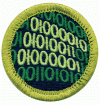 Programming
Programming
Changes were made to requirements 1b and 3a as shown below.
- Discuss first aid and prevention for potential injuries, such as eyestrain and repetitive stress the types of injuries, that could occur during programming activities, including repetitive stress injuries and eyestrain.
- Create a list of ten 5 popular programming languages in use today and describe which industry or industries they are primarily used in and why.
 Reptile
and Amphibian Study
Reptile
and Amphibian Study
Requirement 3d was deleted and 3e renumbered as 3d, and a change was made to requirement 5 as shown below.
- Salamanders and lizards
e. Snakes and lizards- Describe how reptiles and Compare how reptiles reproduce to how amphibians reproduce.
 Salesmanship
Salesmanship
Changes were made to requirements 2b, 2b, 3, 4, 6a3 as shown below.
- Learn all about the product or service to be sold.
- Follow up with customers after their purchase to confirm their satisfaction and discuss their concerns about the product or service.
- Write and present a sales plan for a product or service and a sales territory assigned by your counselor.
- Make a sales presentation of a product or service assigned by your counselor.
- How is the product or service sold?
 Small-Boat
Sailing
Small-Boat
Sailing
A new requirement was added as item 6i, and old requirement 6i was renumbered as 6j as shown below.
- Accept a single line or side tow and maneuver the craft being towed safely for 20 boat lengths.
- i. Upon returning to the dock, mooring, or beach, properly secure all equipment, furl or stow sails, and prepare the craft for unattended docking or beaching overnight or longer.
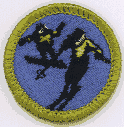 Snow
Sports
Snow
Sports
Changes were made to requirement 2b, and the following parts of requirement 7:
- In the Downhill (Alpine) Skiing option: changes to requirements a, h, and i, and deletion of requirements h1, h2, and h3
- In the Cross-Country (Nordic) Skiing option: changes to requirements a, b, d, and i
- In the Snowboarding option: changes to requirement i, deletion of requirements i1, i2, and i3, and deletions of the 3 items after requirement k, which were included in error)
- In the Snowshoring option: requirement e was replaced, requirement i was replaced with a revised version of requirement j, and a new requirement j was added.
The changes are shown below.
-
- Explain the procedure used to report an accident to the local ski patrol for the area where you usually ski, ride, or snowshoe. or local emergency personnel.
-
- Downhill (Alpine) Skiing
- Show how to use wax and maintain your own release bindings and explain the use of two others. skis and use/maintain your release bindings. Explain the international DIN standard and what it means to skiers.
- Make a controlled run down an intermediate slope.
and demonstrate the following:
- Short-, medium-, and long-radius parallel turns
- A sideslip and safety (hockey) stop to each side
- Traverse across a slope
- Demonstrate the ability to ski in varied conditions, including changes in pitch, and snow conditions, and moguls. Maintain your balance and ability to turn.
- Cross-Country (Nordic) Skiing
- Show your ability to select, use, and repair, if necessary, the correct equipment for ski touring maintain equipment for cross-country skiing in safety and comfort.
- Discuss classical and telemark skis. Demonstrate two ways to carry skis and poles safely and easily. classic, skating, touring, and telemark skis
- Discuss the differences between cross-country skiing, ski , backcountry/ski touring, ski mountaineering, and downhill downhill/telemark skiing.
- Demonstrate your ability, on a 4 mile tour, to cope with an average variety of snow conditions.
- Snowboarding
- Make a controlled run down an intermediate slope.
and demonstrate the following:
- Skidded, carved, and jump turns
- Stops
- Riding fakie
- (Note: The next 3 lines were
included in the text in error)
- Short-, medium-, and long-radius parallel turns
- A sideslip and safety (hockey) stop to each side
- Traverse across a slope
- Make a controlled run down an intermediate slope.
and demonstrate the following:
- Snowshoeing
- Describe how to make an emergency
snowshoe.
List the items you would take on a one-day snowshoe hike - Take a two-mile snowshoe hike
with a buddy or your troop.
j. Demonstrate your ability, on a 2-mile snowshoe hike, to cope with an average variety of to snow conditions. - Demonstrate the proper use of a topographic map and compass.
- Describe how to make an emergency
snowshoe.
- Downhill (Alpine) Skiing
 Sports
Sports
The requirements for the Sports merit badge were revised in 2021. However, the previous (2017-2021) requirements were used as the basis for the 2023 revision, rather than using the 2021-2022 version. One of the changes in 2021 was the switching the order of requirements 4 and 5.
Since it is unclear as to which set of requirements were supposed to be used, we have created web pages and worksheets for both the pre-2021 requirements with the 2023 revisions, and the 2021 requirements with the 2023 revisions.
Click here for the version
using the revised Pre-2021 requirements
Click here for the version using the revised
2021 requirements
Changes were made to requirement 5 (based on the pre-2021 version) or 4 (based on the 2021 version) , and a note was added which applies to that requirement. The changes are shown below.
- Take part for one season (or four months) as a competitive individual or as a member of an organized team in TWO of the following sports: baseball, basketball, bowling, cross-country, field hockey, football, diving, field hockey, flag football, flagteam, golf, gymnastics, ice hockey, lacrosse, soccer, softball, swimming, spirit/cheerleading, swimming, tackle football, table tennis, tennis, track and & field, volleyball, water polo, and wrestling, and/or badminton. Your counselor may approve in advance other recognized sports.* , but not any sport that is restricted and not authorized by the Boy Scouts of America. Then with your chosen sports do the following:
* The BSA has prohibited as official Scouting activities intramural, interscholastic, or club-sport competitions or activities. However, they can be acceptable for your individual participation in an organized school, league, or club activity if approved by your counselor.
 Swimming
Swimming
A change was made to requirement 5a as shown below.
- Float face up in a resting position for at least one minute three minutes with minimal movement..
Changes to Special Opportunities
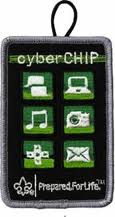 Cyber
Chip
Cyber
Chip
The requirements for the Cyber Chip were removed from the 2023 Scouts-BSA Requirements book. The award was NOT discontinued, however.
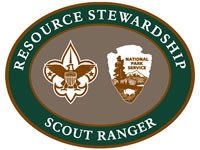 National
Park Service Resource Stewardship Scout Ranger
National
Park Service Resource Stewardship Scout Ranger
The last sentence of the entry for this award, shown below, was deleted.`
Additional information may be found at www.nps.gov/fost/learn/kidsyouth/upload/Scout-Ranger-Brochureonepage7-20-09-2.pdf.
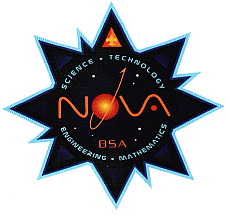 Nova
and Supernova Awards
Nova
and Supernova Awards
Information about the Nova and Supernova Awards was removed from the 2023 Scouts-BSA Requirements book. The program was NOT discontinued, however.
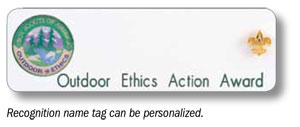 BSA
Outdoor Ethics Action Award
BSA
Outdoor Ethics Action Award
Requirement 3b was revised as shown below.
- Participate in an outing that emphasizes the complete set of Leave No Trace ( http://lnt.org/learn/7-principles lnt.org/learn/7-principles) or relevant Tread Lightly! (www.treadlightly.org/learn) principles. All members of the troop participating in the outing should use outdoor ethics and the specific skills needed to minimize impacts from their use of the outdoors.
 Religious
Emblems
Religious
Emblems
The contact information for Episcopal Emblems was revised and now reads as follows:
Episcopal - God and Church; God and Life.
Local council service center or
P.R.A.Y.,
11123 S. Towne Square, Suite B,
St. Louis, MO 63123;
telephone: 314-845-3318;
email: scouting@brothersandrew.net or
info@praypub.or
websites: https://www.brothersandrew.net/Ministries/scouting.html"
www.brothersandrew.net/Ministries/scouting.html
and www.praypub.org/bsa
This analysis was prepared as a service to Scouts and
Scouters nationwide
Paul S. Wolf, Secretary, US Scouting Service Project, Inc.
This document is a product of the U.S. Scouting Service Project, Inc. (USSSP). It may be reproduced by or for Scouting volunteers and used locally for training purposes consistent with the programs of the Boy Scouts of America (BSA), the World Organization of the Scout Movement (WOSM) or other Scouting and Guiding Organizations. However, it may not be used or reproduced for electronic redistribution or for commercial or other non-Scouting purposes without the express permission of the U. S. Scouting Service Project, Inc. (USSSP) or other copyright holders. The USSSP is not affiliated with BSA or WOSM and does not speak on behalf of BSA or WOSM. Opinions expressed in this document are those of the web authors.
A print (PDF) version of this document can be downloaded
here.
Printed copies of this document may be freely distributed for use in the
Scouting program,
so long as the source is acknowledged, but copying the information to another
web site is NOT authorized.
© 2022 - U.S. Scouting Service Project, Inc. - All Rights
Reserved
Much of the text and images reproduced herein are © - Boy Scouts of America,
and are used by permission.







